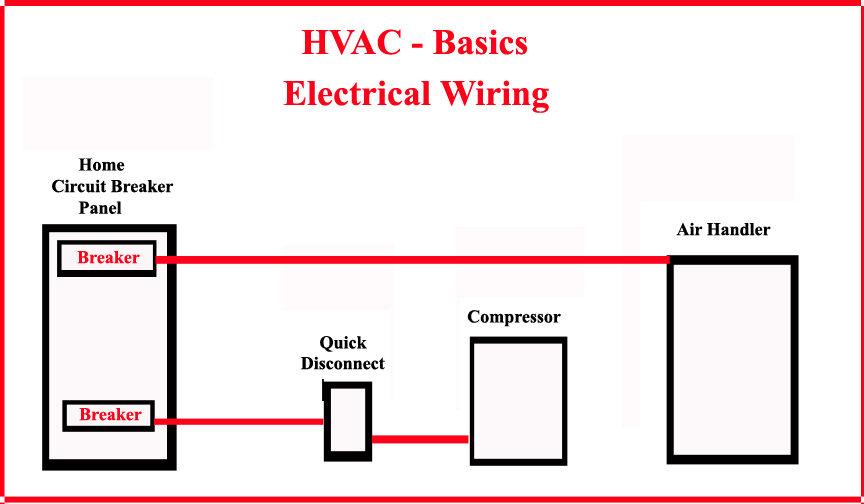
Shared Knowledge
"Heating, Ventilation and Air Conditioning (HVAC) - Basics"
1 August 2012
Summary: HVAC is not rocket science but information about HVAC is scattered all over the Internet. In this document, I try to define in a concise way.
Background:
There are 4 different aspects of HVAC:
- Components.
- High voltage electrical wiring.
- Control wiring and circuit boards.
- Refrigerant.
Components:
A HVAC system that is either just air conditioning or a heat pump consists of:
- A wall mounted thermostat.
- An air handler, which is inside the house either in a closet, utility room or in the attic. The air handler contains coils that either absorb or give off heat. Heated or cooled air is then circulated through the duct system via an air handler blower motor.
- Compressor unit. The compressor is located outside and again contains coils, a compressor motor and a fan that moves outside air through the compressor's coils and up and then away from the unit.
HVAC with a furnace has a natural gas or oil-fired burner as part of the air handler.
High voltage electrical wiring:
Electrical wiring of HVAC is rather straight forward, BUT dangerous.
Never work on HVAC unless you are absolutely, positively, sure high voltage circuits are dead. THIS MEANS USING A VOLTMETER!
Note(s:) (1) Probably 2 circuit breakers or one for air handler and one for compressor. These breakers will be large. (2) The quick disconnect shown will be outside near compressor unit and may be fused or un-fused.
HVAC control wiring:
The wall mounted thermostat controls HVAC but obviously you would not want 240volts alternating current (VAC) present at a wall thermostat so control voltage and wiring is used.
24VAC is the control voltage of HVAC (non-lethal)
In the air handler, there is a transformer that converts 120VAC to 24VAC.
Note(s): (1) Control voltage is 24 volts alternating current (VAC), low current. Inside the air handler is a 24 volt transformer that supplies 24VAC to the thermostat and to the compressor contactor (HVAC relay). (2) When thermostat demands cool air, the air handler blower is switched on and control voltage sent to contactor in compressor, switching on the compressor.
But many systems consist of more than just HVAC, they also might be heat pumps or an air conditioning unit with an oil or gas fired burner.
Note(s): in a heat pump variation of HVAC, there is a control board mounted in the compressor unit.
Note(s): in a HVAC with an oil or natural gas fired burner, there is a control board in the air handler.
Notes: (1) "all" HVAC air handlers route condensate out of the unit to the outside via piping but sometimes the pipe clogs and water overflows. (2) To ensure condensate water from an attic mounted air handler does not leak down into the rooms below, a pan is placed under the air handler with an additional outside pipe. (3) Some overflow pan systems include a float switch such that if water collects in the overflow pan, the float switch turns off the system. (4) As I do not have such a system, can not tell you how you know your system is not working because of the float switch unless you inspect the pan.
In summary then, depending on your system, you may have a control board in the compressor unit or the air handler and perhaps a flow switch on the overflow pan under your air handler. Again, control is 24VAC and is low current.
Refrigerant:
A HVAC system works by:
(1) Compressing a gas to a liquid (compressor).
(2) Removing the heat from the liquid caused by compressing the gas via coils and a fan (compressor unit).
(3) Routing the liquid to an air handler.
(4) Allowing the liquid to expand to a gas which absorbs heat via coils in the air handler.
(5) Pulling house internal air across the cooled coils.
(5) Air handler air is then routed via ducts throughout the cooled space.
(6) Routing the gas back to the compressor where it is compressed and the cycle begins again.
A heat pump is only a variation of above in that instead of the coils in the air handler absorbing heat, they give off heat.
There are 2 major types of HVAC refrigerants: R22 and R410A.
Most systems built before 2010 use R22.
R22 depletes the earth's ozone layer and the United States is a partner in the world-wide agreement to ban R22 use.
Because of ozone damage due to improper servicing of a R22-based unit, an EPA license is required.
A home owner can not buy R22.
R22 withdrawn from a system must be recycled.
R22 will be around for many years and is available to service technicians.
New HVAC systems use R410a. This refrigerant does not deplete the ozone layer.
R410a can not be placed in a system designed for R22.
Conversion from an R22-based system to an R410a system requires replacement of the compressor and air handler.